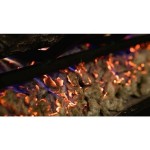Antique Fireplace Mantles: A Glimpse into History and Style
Antique fireplace mantles are more than just decorative elements; they are historical artifacts that tell stories of craftsmanship, design, and the evolution of home aesthetics. These architectural features can add a touch of elegance, warmth, and character to any room, transforming a simple fireplace into a focal point that evokes a sense of history and sophistication.
Antique fireplace mantles come in a wide range of styles, materials, and periods. From the ornate carvings of the Victorian era to the sleek lines of Art Deco, each mantle reflects the artistic sensibilities of its time. These pieces can serve as a window into the past, offering insights into the architectural trends and decorative preferences of bygone eras.
A History of Styles and Materials
The history of fireplace mantles is closely intertwined with the evolution of architectural styles. Early mantles, often constructed from simple stone or brick, served primarily functional purposes, providing a surface above the hearth for tools and candles. As architectural styles progressed, mantles became more elaborate, incorporating ornate carvings, decorative moldings, and intricate details.
Some of the most prominent styles of antique fireplace mantles include:
- Georgian (1714-1837): Characterized by symmetry, simplicity, and classical elements. Often made of wood, painted white or in muted colors, with simple moldings and carvings.
- Regency (1811-1830): Embracing a more romantic and ornate style, with elaborate carvings, swirling designs, and a preference for lighter woods.
- Victorian (1837-1901): Known for its opulence and grandeur, with highly decorated mantles featuring intricate carvings, elaborate moldings, and a wide range of materials, including marble, wood, and cast iron.
- Art Nouveau (1890-1910): Embracing organic forms and flowing lines, with decorative elements inspired by nature, often crafted from wood, metal, or ceramic.
- Art Deco (1920-1939): Characterized by geometric patterns, bold colors, and streamlined forms. Mantles in this style often incorporate metallic accents, lacquered finishes, and geometric designs.
In terms of materials, antique fireplace mantles were crafted from a wide range of materials, including:
- Wood: A popular choice for its versatility and ease of carving. Oak, mahogany, walnut, pine, and cherry were among the most commonly used woods.
- Marble: Renowned for its elegance and durability, marble was often used for its striking veining and polished finish.
- Stone: Limestone, sandstone, granite, and slate were commonly used materials, offering a sense of rustic charm and durability.
- Cast Iron: A sturdy and versatile material, cast iron was often used to create intricate designs and ornate embellishments.
Identifying and Appraising Antique Fireplace Mantles
Identifying and appraising antique fireplace mantles requires a keen eye for detail and a knowledge of historical styles and materials. Some key factors to consider when assessing an antique mantle include:
- Style and Period: Determining the style and approximate period of the mantle is crucial for understanding its historical significance and market value.
- Material: The type of material used, its quality, and craftsmanship can significantly impact the mantle's value.
- Condition: The condition of the mantle, including any damage, repairs, or restoration, is a major factor in its appraisal.
- Origin and Provenance: Knowing the origin and provenance of the mantle, such as the maker, historical background, or previous owners, can add to its value and desirability.
Professional appraisers can provide expert assessments of antique fireplace mantles, considering all these factors to determine a fair market value. They can also offer guidance on restoration and conservation, ensuring that these historical treasures are preserved for future generations.
Restoring and Preserving Antique Fireplace Mantles
Antique fireplace mantles, with their intricate details and delicate materials, often require specialized care and restoration. Experienced artisans and conservators possess the knowledge and skills to address various restoration needs, including:
- Cleaning and Polishing: Specialized cleaning techniques are used to remove dirt, grime, and accumulated residues, restoring the original finish and revealing the inherent beauty of the material.
- Repairing Cracks and Damages: Skilled artisans can expertly repair cracks, chips, and other damages using techniques that maintain the integrity and authenticity of the antique.
- Refinishing: When necessary, professionals can refinish the mantle using traditional methods and materials, preserving its original character while enhancing its appearance.
- Conservation: Conservation efforts focus on protecting the mantle from further deterioration, using appropriate handling techniques, environmental controls, and preventive measures.
Investing in professional restoration and conservation services is essential for preserving the beauty and historical significance of antique fireplace mantles. It ensures that these architectural treasures remain a cherished part of the home and a testament to the craftsmanship and artistry of the past.

Antique Fireplace Mantel 70 X 100 The Door

Antique Wood Marble Carved Fireplace Mantels Oley Valley Architectural Antiques

Antique Wood Marble Carved Fireplace Mantels Oley Valley Architectural Antiques

Vintage Fireplace Mantel Recycling The Past Architectural Salvage

Antique Combed Stained Fireplace Mantel With Insert And Hearth Surrounds

Restoration Resources New England S Primary Source For Authentic Architectural Antiques Wood Mantels Section

Antique Fireplace Mantel 66 ⅛ X 81 ½ The Door

Majorca Cast Stone Fireplace Mantels Old World Stoneworks

Antique Wooden Fireplace Mantel Carved With Satyr And Columns 19th Century Italy For At 1stdibs Mantels Mantles

Original And Amazingly Intact 1880 S Antique American Eastlake Style Tennessee Marble Fireplace Mantel Salvaged From A Chicago Residence Undergoing Demolition
Related Posts








